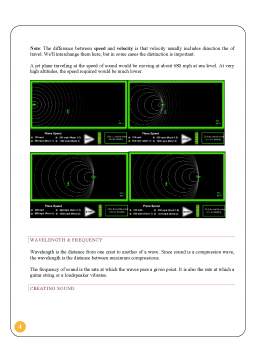Extras din proiect
A sound wave is a model of perturbation caused by the movement of the energy traveling through a medium (as: air, water or any other material, solids liquid or gasses), where this is propagating away from the source of sound.
The source is an object that creates a vibration, as a ring from a phone or the vocal cords of a person. Vibrations disturb particles from the surrounding medium, these particles disturbs the particles nearby them, and so on. The model of disturbance creates a circle exterior as in a model of a wave, as those waves on the ocean. The energy of sound is send trough wave, usualy in all the directions and less intense mean time that is traveling away from the source.
Sound is a regular mechanical vibration that travels through matter as a waveform. Although it is commonly associated in air, sound will readily travel through many materials, such as water and steel. Some insulating materials absorb much of the sound waves, preventing the waves from penetrating the material.
ABOUT SOUNDS | A BIT OF HISTORY
Sound (definition)” is a travelling wave which is an oscillation of pressure transmitted through a solid, liquid, or gas, composed of frequencies within the range of hearing and of a level sufficiently strong to be heard, or the sensation stimulated in organs of hearing by such vibrations.
The idea of sound wave had appeared since antiquity. Crisipus, Greek philosopher (. 240 B.C.), and Vetruvius, Roman engineer (25 B.C.), had revealed the hypothesis that every sound represents a movement of particles under the shape of a wave, undulation.
The first practical modality for recording the sound was invented in 1877 by Thomas Edison. The sound was captured by a funnel and used to produce vibration to a needle, that was based on a rotating cylinder, and the cylinder digs in a ditch with bumps, when the recording is diffused a needle followed the ditch reproducing the original sound this device is called (gramophone).
At the beginning of XX century the quality of sound have been improved once that the microphone had been invented. The microphone transforms the sound into an electric signal which triggers a device that produces a ditch.
The speculations that sound are a wave phenomenon grew out of observations of water waves. The rudimentary notion of a wave is an oscillatory disturbance that moves away from some source and transports no discernible amount of matter over large distances of propagation. The wave interpretation was also consistent with Aristotle's (384-322 B.C.) statement to the effect that air motion is generated by a source: "thrusting forward in like manner the adjoining air, to that the sound travels unaltered in quality as far as the disturbance of the air manages to reach."
A pertinent experimental result inferred with reasonable conclusiveness by the early seventeenth century, with antecedents dating back to Pythagoras (c. 550 B.C.) and perhaps even further, is that the air motion generated by a vibrating body sounding a single musical note is also vibratory and of the same frequency as the body.
The mathematical theory of sound propagation began with Isaac Newton (1642-1727), whose Principia (1686) included a mechanical interpretation of sound as being "pressure" pulses transmitted through neighboring fluid particles. Substantial progress toward the development of a viable theory of sound propagation resting on firmer mathematical and physical concepts was made during the eighteenth century by Euler (1707-1783), Lagrange (1736-1813), and d'Alembert (1717-1783). During this era, continuum physics, or field theory, began to receive a definite mathematical structure. The theory ultimately proposed for sound in the XVIII-the century was incomplete from many standpoints, but modern theories of today can be regarded for the most part as refinements of that developed by Euler and his contemporaries.
SOUND WAVES | CLASSIFICATION OF SOUNDS
Sound waves are classified in:
- Infrasound: Geologists use sound waves by analyzing the returned waves to get images of layers of rock. Infrasound is composed of sound waves varying frequencies less than 25 Hz value is lower limit of human hearing. The sounds of this period are called subsonic.
- Ultrasounds: These are composed from sound waves that oscillate at hi frequencies higher than 14 kHz the upper limit for the majority of adults. Ultrasonic waves penetrates better than low frequency sounds, which is why the ultra sound is used in certain types of sonar devices medical scanners and offers images of internal organs. Also, ultrasound can detect echoes of defects inside the welded metal objects.
- Perception of sound: As a signal perceived by one of the major senses, sound is used by many species for detecting, navigation, predation, and communication.
- Physics of sound: As a signal perceived by one of the major senses, sound is used by many species for detecting, navigation, predation, and communication.
SOUNDS WAVES | ACOUSTICS AND NOISE
The scientific study of propagation, absorption, and reflexion of sound waves is called acoustic. The level of noise is a term used usually for referring at a not wanted sound.
Since the human ear does not have a flat spectral response, sound pressures are often frequency weighted so that the measured level will match perceived levels more closely. The International Electro technical Commission (IEC) has defined several weighting schemes. A-weighting attempts to match the response of the human ear to noise and A-weighted sound pressure levels are labeled dBA. C-weighting is used to measure peak levels.
Preview document
Conținut arhivă zip
- Sound Waves.doc















